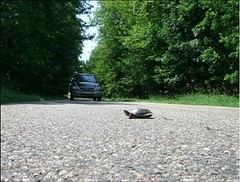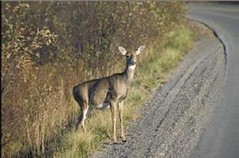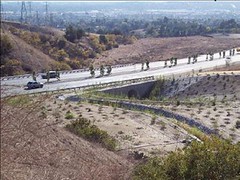Sprawl and highways hurt wildlife – so why aren’t states spending the available money to reduce the conflicts?

Posted July 1, 2008 at 1:33PM
While the emphasis of this blog is on community development and smart growth, one of the reasons I promote those solutions so enthusiastically is to reduce development pressure on our working and natural landscapes. Many species of wildlife, in particular, need room to roam in order to survive, and when we invade and divide their habitat we change our ecology and diminish the wonders of nature. Not good.
 One of the most menacing man-made problems for wildlife is our road system, which according to the conservation organization Defenders of Wildlife affects animals both directly with vehicle collisions that cause roadkill and indirectly via degradation, fragmentation and loss of habitat.
One of the most menacing man-made problems for wildlife is our road system, which according to the conservation organization Defenders of Wildlife affects animals both directly with vehicle collisions that cause roadkill and indirectly via degradation, fragmentation and loss of habitat.
According to Defenders’ Habitat and Highways program, “Recent estimates indicate between 725,000 and 1,500,000 animals are struck on our roads annually. Wildlife-vehicle collisions can take a toll on species at the population level and, in some cases, push some rare species closer to extinction. Statistics for human victims are grim as well — 200 fatalities, 29,000 injuries and more than $1 billion in property damage every year as a result of wildlife-vehicle collisions.”
Beyond collisions, roads fragment habitat by creating barriers that animals will not or cannot cross and survive. As the Biodiversity Partnership puts it, this “chops the landscape into smaller, disconnected pieces that cannot sustain healthy wildlife populations. Species dependent on habitat interiors or with large habitat area requirements are especially vulnerable to fragmentation . . . Only certain species, such as those that are adapted to habitat edges or dependent upon human activity, are able to persist in these fragmented habitats.” Plant communities are affected, too, because barriers interfere with pollination.
 My friend Trisha White directs the Habitat and Highways program, and she and her colleagues have released a new publication highlighting the availability of federal funds to help reduce these negative impacts. It is called The $61 Million Question: How Can Transportation Enhancements Benefit Wildlife? and it is designed to help conservationists, departments of transportation, and resource managers tap the available resources for good pro-wildlife, transportation-related projects, many of which are highlighted in the report as examples.
My friend Trisha White directs the Habitat and Highways program, and she and her colleagues have released a new publication highlighting the availability of federal funds to help reduce these negative impacts. It is called The $61 Million Question: How Can Transportation Enhancements Benefit Wildlife? and it is designed to help conservationists, departments of transportation, and resource managers tap the available resources for good pro-wildlife, transportation-related projects, many of which are highlighted in the report as examples.
The title is derived from the amount of money that could be available, on average, to each state if the states allocated one-twelfth of their available “transportation enhancements” funds equally among the twelve eligible categories, including wildlife projects. Sadly, only around $11.5 million, on average, is spent on wildlife from the available funds. Trisha and her colleagues hope to give the program a boost with the report.
 (Transportation Enhancements is a federal program that recognizes the negative impacts that transportation infrastructure can have on communities and the landscape, and makes funds available for all sorts of great projects to compensate. Other eligible categories include bicycle and pedestrian facilities, scenic and historic easements, welcome centers and roadside beautification.)
(Transportation Enhancements is a federal program that recognizes the negative impacts that transportation infrastructure can have on communities and the landscape, and makes funds available for all sorts of great projects to compensate. Other eligible categories include bicycle and pedestrian facilities, scenic and historic easements, welcome centers and roadside beautification.)
As conservationist David Burwell writes in the report’s preface, “it is up to state wildlife agencies and citizen advocates to sit down with state transportation agencies and map out plans for accomplishing these important ‘wildlife retrofits.’ Many state transportation agencies do not have the in-house expertise needed to strategically program funds to maximize wildlife protection as a co-benefit of transportation planning and system management.”
Some of the best examples in the new report are wildlife crossing facilities that have been built beneath or above freeways and other roads.  The crossing beneath Harbor Boulevard in Los Angeles, at left, was built with Enhancements funding and restores connectivity between patches of habitat. The photo comes originally from the Puente Hills Landfill Native Habitat Preservation Authority (all images in this post are from the new report), which was instrumental in getting the project done.
The crossing beneath Harbor Boulevard in Los Angeles, at left, was built with Enhancements funding and restores connectivity between patches of habitat. The photo comes originally from the Puente Hills Landfill Native Habitat Preservation Authority (all images in this post are from the new report), which was instrumental in getting the project done.
Other types of projects include acquiring habitat to re-establish habitat connectivity, installing fencing or other structures to guide wildlife towards crossings, identifying collision hotspots through tracking, telemetry, and cameras, evaluating roadside vegetation, removing invasive species and planting native species along right-of-ways and on neighboring properties, and many more listed in the report.
Download it here.